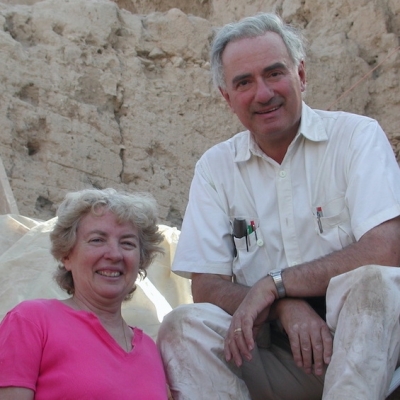Balzan Prize Awarded to Giorgio Buccellati and Marilyn Kelly-Buccellati
On February 2, the International Balzan Prize Foundation announced that Giorgio Buccellati and Marilyn Kelly-Buccellati were awarded the 2021 Balzan Prize for Art and Archaeology of the Ancient Near East. This prestigious prize is awarded annually to a maximum of four recipients and includes a cash component for each recipient of approximately $800,000, half of which must be invested in research by young researchers. Previous winners have included several Nobel Prize laureates. The aim of the prize “is to foster culture, the sciences, and the most meritorious initiatives in the cause of humanity, peace and fraternity among peoples throughout the world.” The presentation of the prize will be on July 1 in Bern, Switzerland. Giorgio Buccellati is professor emeritus of the departments of History and Near Eastern Languages and Cultures and the founding director of the Institute of Archaeology at UCLA (now the Cotsen Institute of Archaeology). He is also the director of the Mesopotamian Laboratory. Marilyn Kelly-Buccellati is professor emerita of archaeology and art history, California State University–Los Angeles. Both are researchers affiliated with the Cotsen Institute. The Buccellatis received the award “for their achievements in the study of Hurrian culture and for highlighting its importance as the foundation of a great urban civilization, among the most flourishing in the ancient Near East in the third millennium BCE; for promoting a digital approach to the study of archaeology; and for enhancing theoretical reflection on the nature of this discipline,” according to the announcement by the Balzan Prize Foundation. The International Balzan Foundation was created in Lugano in 1956 by Lina Balzan, daughter of Eugenio Francesco Balzan. Upon his death she decided to use his wealth to honor his memory. Eugenio Balzan was born on April 20, 1874 in Badia Polesine, near Rovigo in northern Italy, into a family of landowners. He spent almost his entire working life at Corriere della Sera, the leading newspaper in Milan. After joining the paper in 1897, he worked his way up from editorial assistant, to news editor and special correspondent. In 1903, editor Luigi Albertini made him managing director of the paper’s publishing house, of which he became a partner and a shareholder. In 1933 he left Italy and moved to Switzerland, where he had successfully invested his fortune. He continued his significant charitable activities until his death in Lugano, Switzerland, in 1953. Nominating letters on behalf of the Buccellatis came from an array of distinguished international scholars who have worked with them over the years. The letters praised their efforts in the areas of archaeological theory, art history, conservation, digital analysis, field work, institutional commitment, and public archaeology. The nominating letters were signed by Max Hollein, director, and Daniel Weiss, president and CEO of the Metropolitan Museum of Art, New York; Tim Whalen, director, Getty Conservation Institute, Los Angeles; Sarah Kansa, executive director and Eric Kansa, program director, Open Context, Berkeley; Wang Wei, president, Institute of Archaeology, Chinese Academy of Sciences; Nazeer Awad, director general, Directorate General of Antiquities and Museums, Damascus (Syria); Christian Greco, director, Museo Egizio, Turin; Stefano Valentini, director, Center for Ancient Mediterranean and Near Eastern Studies, Florence; and Willeke Wendrich, director, Cotsen Institute of Archaeology. In the letter from the Getty Conservation Institute, Whalen praises the work of the Buccellatis in that it “reflects an extraordinary blend of scholarly erudition and pragmatic commonsense. They see near and far. Practicing archaeologists who have embraced both site and artifact conservation, innovators and experimentalists, brilliant networkers across multiple disciplines with the ability to engage help effortlessly from others with different expertise—these are the attributes of Giorgio and Marilyn. Their contribution to the integration of preservation, archaeology, and community comprises a milestone. Their record of accomplishment is stellar. We stand in admiration of their inventive ways of harnessing the benefits of archaeology for a larger purpose and in ways they never would have imagined—as a bulwark against the ravages of war.” The director of the Cotsen Institute, Willeke Wendrich, congratulated the Buccellatis, whom she has known as colleagues for more than twenty years, on their well-deserved award, which she enthusiastically supported. In her letter of nomination, among their many accomplishments, she extolled both professors as “great educators. They have trained students from UCLA, several Italian universities, the University of Damascus, and school children from the nearby city of Qamishli. They are fundamentally concerned with the safety and well-being of their Syrian counterparts and support a large community by helping to develop economic opportunities. Central to their work are the deep historical roots of the region; at the forefront of their minds are the living communities.” For further insights into the work of the Buccellatis, please see the volume in honor of their studies, Between Syria and the Highlands, written by 51 scholars from universities and research centers around the world, including several affiliated with the Cotsen Institute. For more information, or to find out how to support our research and education in archaeology and conservation, please contact Michelle Jacobson at mjacobson@ioa.ucla.edu.


Leave a Reply
Want to join the discussion?Feel free to contribute!